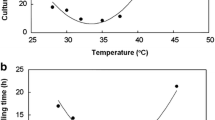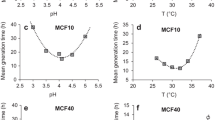Abstract
A comprehensive physiological and phylogenetic characterisation was carried out of “Thiobacillus ferrooxidans” m-1, an acidophilic iron-oxidizing bacterium first described over 25 years ago. Phylogenetically, strain m-1 is a gammaproteobacterium, most closely related to alkaliphilic Ectothiorhodospira spp. and only distantly to iron-oxidizing acidithiobacilli. Physiological examination confirmed that strain m-1 can grow autotrophically not only by ferrous iron oxidation but also, in contrast to previous reports, by oxidation of elemental sulfur, sulfide and tetrathionate, using either oxygen or ferric iron as terminal electron acceptor. The bacterium was also found to be thermo-tolerant, growing optimally at 38°C and up to a maximum of 47°C. Growth in liquid media required an external osmotic potential of >2 bar, and was optimal at ~5 bar, though no growth occurred where the medium osmotic potential was close to that of sea water (~26 bar). From this, it was concluded that strain m-1 is a moderate osmophile. Strain m-1 was also shown to be diazotrophic and tolerant of elevated concentrations of many metals typically found in mine-impacted environments. On the basis of these data, m-1 is proposed as the type strain of a new genus and species of bacteria, Acidiferrobacter thiooxydans (DSM 2392, JCM 17358).





Similar content being viewed by others
References
Bradford MM (1976) A rapid and sensitive method for the quantitation of microgram quantities of protein utilizing the principle of protein-dye binding. Anal Biochem 72:248–254
Chun J, Lee JH, Jung Y, Kim M, Kim S, Kim BK, Lim YW (2007) EzTaxon: a web-based tool for the identification of prokaryotes based on 16S ribosomal RNA gene sequences. Int J Syst Evol Microbiol 57:2259–2261
Davis-Belmar CS, Nicolle JLC, Norris PR (2008) Ferrous iron oxidation and leaching of copper with halotolerant bacteria in ore columns. Hydrometallurgy 94:144–147
Galleguillos P, Hallberg KB, Johnson DB (2009) Microbial diversity and genetic response to stress conditions of extremophilic bacteria isolated from the Escondida copper mine. Adv Mat Res 71–73:55–58
Garcia-Moyano A, Gonzalez-Toril E, Aguilera A, Amils R (2007) Prokaryotic community composition and ecology of floating macroscopic filaments from an extreme acidic environment, Rio Tinto (SW, Spain). Syst Appl Microbiol 30:601–614
Hallberg KB, Johnson DB (2007) Isolation, enumeration, growth, and preservation of acidophilic prokaryotes. In: Hurst CJ, Crawford RL, Garland JL, Lipson DA, Mills AL, Stetzenbach LD (eds) Manual of environmental microbiology, 3rd edn. American Society of Microbiology Press, Washington, DC, pp 1155–1165
Hallberg KB, Coupland K, Kimura S, Johnson DB (2006) Macroscopic streamer growths in acidic, metal-rich mine waters in north Wales consist of novel and remarkably simple bacterial communities. Appl Environ Microbiol 72:2022–2030
Hallberg KB, González-Toril E, Johnson DB (2010) Acidithiobacillus ferrivorans, sp. nov.; facultatively anaerobic, psychrotolerant iron-, and sulfur-oxidizing acidophiles isolated from metal mine-impacted environments. Extremophiles 14:9–19
Harrison AP Jr (1982) Genomic and physiological diversity amongst strains of Thiobacillus ferrooxidans, and genomic comparison with Thiobacillus thiooxidans. Arch Microbiol 131:68–76
Harrison AP Jr (1984) The acidophilic thiobacilli and other acidophilic bacteria that share their habitat. Annu Rev Microbiol 38:265–292
He Z, Xie XH, He ZG, Xiao SM, Liu JS (2007) Microbial diversity of mine water at Zhong Tiaoshan copper mine, China. J Basic Microbiol 47:485–495
Imhoff JF (2006) The family Ectothiorhodospiraceae. In: Dworkin M, Falkow S, Rosenberg E, Schleifer KH, Stackebrandt E (eds) The prokaryotes: a handbook on the biology of bacteria, vol 6, 3rd edn. Springer, New York, pp 874–886
Johnson DB, Hallberg KB (2007) Techniques for detecting and identifying acidophilic mineral-oxidizing microorganisms. In: Rawlings DE, Johnson DB (eds) Biomining. Springer, Berlin, pp 237–261
Johnson DB, Hallberg KB (2008) Carbon, iron and sulfur metabolism in acidophilic micro-organisms. Adv Microb Physiol 54:202–256
Johnson DB, Bacelar-Nicolau P, Okibe N, Thomas A, Hallberg KB (2009) Characteristics of Ferrimicrobium acidiphilum gen. nov., sp. nov., and Ferrithrix thermotolerans gen. nov., sp. nov.: heterotrophic iron-oxidizing, extremely acidophilic actinobacteria. Int J Syst Evol Microbiol 59:1082–1089
Kelly DP, Wood AP (2000) Reclassification of some species of Thiobacillus to the newly designated genera Acidithiobacillus gen. nov., Halothiobacillus gen. nov. and Thermithiobacillus gen. nov. Int J Syst Evol Microbiol 50:511–516
Kelly DP, Chambers LA, Trudinger PA (1969) Cyanolysis and spectrophotometric estimation of trithionate in mixture with thiosulfate and tetrathionate. Anal Chem 41:898–902
Kolmert Å, Wikström P, Hallberg KB (2000) A fast and simple turbidimetric method for the determination of sulfate in sulfate-reducing bacterial cultures. J Microbiol Methods 41:179–184
Lane DJ, Harrison AP, Stahl D, Pace P, Giovannoni SJ, Olsen GJ, Pace NR (1992) Evolutionary relationships among sulfur- and iron-oxidizing eubacteria. J Bacteriol 174:269–278
Larkin MA, Blackshields G, Brown NP, Chenna R, McGettigan PA, McWilliam H, Valentin F, Wallace IM, Wilm A, Lopez R, Thompson JD, Gibson TJ, Higgins DG (2007) Clustal W and Clustal X version 2.0. Bioinformatics 23:2947–2948
Lovley DR, Phillips EJP (1987) Rapid assay for microbially reducible ferric iron in aquatic sediments. Appl Environ Microbiol 53:1536–1540
Mendez MO, Neilson JW, Maier RM (2008) Characterization of a bacterial community in an abandoned semiarid lead-zinc mine tailing site. Appl Environ Microbiol 74:3899–3907
Mitchell D, Harneit K, Meyer G, Sand W, Stackebrandt E (2004) Systematic analysis of our culture collection for “genospecies” of Acidithiobacillus ferrooxidans, Acidithiobacillus thiooxidans and Leptospirillum ferrooxidans. In: Ciminelli VST, Garcia O Jr (eds) Biohydrometallurgy: fundamentals, technology and sustainable development. Elsevier, Amsterdam, pp 1369–1378
Ñancucheo I, Johnson DB (2010) Production of glycolic acid by chemolithotrophic iron- and sulfur-oxidizing bacteria and its role in delineating and sustaining acidophilic sulfide mineral-oxidizing consortia. Appl Environ Microbiol 76:461–467
Okibe N, Gericke M, Hallberg KB, Johnson DB (2003) Enumeration and characterization of acidophilic microorganisms isolated from a pilot plant stirred tank bioleaching operation. Appl Environ Microbiol 69:1936–1943
Schippers A, Sand W (1999) Bacterial leaching of metal sulfides proceeds by two indirect mechanisms via thiosulfate or via polysulfides and sulfur. Appl Environ Microbiol 65:319–321
Tourova TP, Spiridonova EM, Berg IA, Slobodova NV, Boulygina ES, Sorokin DY (2007) Phylogeny and evolution of the family Ectothiorhodospiraceae based on comparison of 16S rRNA, cbbL and nifH gene sequences. Int J Syst Evol Microbiol 57:2387–2398
Ueda T, Suga Y, Yahiro N, Matsuguchi T (1995) Remarkable N2-fixing bacterial diversity detected in rice roots by molecular evolutionary analysis of nifH gene sequences. J Bacteriol 177:1414–1417
Wakeman K, Auvinen H, Johnson DB (2008) Microbiological and geochemical dynamics in simulated heap leaching of a polymetallic sulfide ore. Biotechnol Bioeng 101:739–750
Wang Q, Garrity GM, Tiedje JM, Cole JR (2007) Naïve Bayesian classifier for rapid assignment of rRNA sequences into the new bacterial taxonomy. Appl Environ Microbiol 73:5261–5267
Acknowledgments
The authors wish to acknowledge financial support for this work from the Biosciences, Environment and Agriculture Alliance (BEAA) between Bangor and Aberystwyth Universities and the European Union (FP7 project “Promine”). DBJ is grateful to the Royal Society for the provision of an Industrial Fellowship. The authors thank Dr. Tadayoshi Kanao, Okayama University Japan, for his contribution to the measurement of specific rates of iron oxidation and Professor Jean Euzéby for his willingness to share his expertise on nomenclature.
Author information
Authors and Affiliations
Corresponding author
Additional information
Communicated by A. Oren.
Electronic supplementary material
Below is the link to the electronic supplementary material.
Rights and permissions
About this article
Cite this article
Hallberg, K.B., Hedrich, S. & Johnson, D.B. Acidiferrobacter thiooxydans, gen. nov. sp. nov.; an acidophilic, thermo-tolerant, facultatively anaerobic iron- and sulfur-oxidizer of the family Ectothiorhodospiraceae . Extremophiles 15, 271–279 (2011). https://doi.org/10.1007/s00792-011-0359-2
Received:
Accepted:
Published:
Issue Date:
DOI: https://doi.org/10.1007/s00792-011-0359-2




